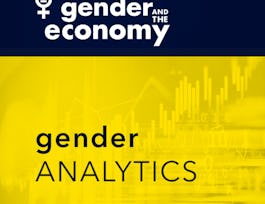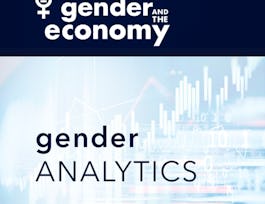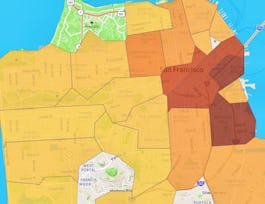This course introduces the principles and practices of human-centered design (also sometimes called “design thinking”) which are essential for developing innovative and inclusive products, services, processes and policies. You will learn by doing, experiencing the design process through exercises and a mini-bootcamp.


Human-Centered Design for Inclusive Innovation
This course is part of Gender Analytics: Gender Equity through Inclusive Design Specialization
Taught in English
Some content may not be translated



Instructors: Sarah Kaplan
6,924 already enrolled
Included with 
Course
(161 reviews)
97%
Recommended experience
What you'll learn
Acquire tools for seeing the world as your users & stakeholders see it, with particular attention to marginalized or silent voices.
Identify latent human needs, looking beyond obvious patterns in quantitative and qualitative data to understand underlying drivers and motivations.
Reframe problems such that innovative and inclusive solutions may emerge through problem finding and not just problem solving.
Learn how to involve users & stakeholders in all stages of design—from ideating to prototyping and testing—& bring a learning mindset to the process.
Skills you'll gain
Details to know

Add to your LinkedIn profile
5 quizzes
Course
(161 reviews)
97%
Recommended experience
See how employees at top companies are mastering in-demand skills

Build your subject-matter expertise
- Learn new concepts from industry experts
- Gain a foundational understanding of a subject or tool
- Develop job-relevant skills with hands-on projects
- Earn a shareable career certificate


Earn a career certificate
Add this credential to your LinkedIn profile, resume, or CV
Share it on social media and in your performance review

There are 4 modules in this course
In this module, you will learn the basics of human-centered design. You will get a taste of working as a designer and walk through the steps of the design process in a mini-bootcamp exercise. At the end of the module, we will discuss how human-centered design fits well with Gender Analytics.
What's included
8 videos3 readings1 quiz1 discussion prompt
Building empathy is the foundation of human-centered design. Problems we’re solving are usually not only ours, but are experienced by other people, such as our employees, customers, clients, colleagues, and others in the community. To truly understand the context and complexity of the problem we’re trying to solve, we need to focus on putting people first and directing our curiosity towards them. In this module, we’re going to dive deeper into the first phase — Empathize. You will learn how to build empathy for target customers or beneficiaries using design-thinking methods. This will help you gain rich insights for your design of a product, service, process or policy.
What's included
6 videos1 reading1 quiz1 discussion prompt
Are you solving the right problem? It doesn’t matter how great your solution is if you are working on the wrong problem. It is important to take the time to understand what you are solving for. In this week, you will learn a few tools and techniques to dig beyond the obvious patterns and draw out key insights to identify the deeper problems to solve. At the end of this week, you will be able to reframe of the problem to solve for your design challenge.
What's included
9 videos2 readings1 quiz2 discussion prompts
Now that you have reframed your challenge, it’s time to start finding innovative solutions. In this module, you will learn how to apply an intersectional gender lens to the ideation process to create an inclusive design, build prototypes to test your ideas, and refine your solution based on feedback.
What's included
8 videos6 readings2 quizzes1 peer review1 discussion prompt
Instructors

Offered by
Recommended if you're interested in Business Essentials

University of Toronto

University of Toronto

University of Toronto

University of Illinois at Urbana-Champaign
Why people choose Coursera for their career




Learner reviews
Showing 3 of 161
161 reviews
- 5 stars
85.71%
- 4 stars
9.93%
- 3 stars
1.24%
- 2 stars
0%
- 1 star
3.10%
New to Business Essentials? Start here.

Open new doors with Coursera Plus
Unlimited access to 7,000+ world-class courses, hands-on projects, and job-ready certificate programs - all included in your subscription
Advance your career with an online degree
Earn a degree from world-class universities - 100% online
Join over 3,400 global companies that choose Coursera for Business
Upskill your employees to excel in the digital economy
Frequently asked questions
Access to lectures and assignments depends on your type of enrollment. If you take a course in audit mode, you will be able to see most course materials for free. To access graded assignments and to earn a Certificate, you will need to purchase the Certificate experience, during or after your audit. If you don't see the audit option:
The course may not offer an audit option. You can try a Free Trial instead, or apply for Financial Aid.
The course may offer 'Full Course, No Certificate' instead. This option lets you see all course materials, submit required assessments, and get a final grade. This also means that you will not be able to purchase a Certificate experience.
When you enroll in the course, you get access to all of the courses in the Specialization, and you earn a certificate when you complete the work. Your electronic Certificate will be added to your Accomplishments page - from there, you can print your Certificate or add it to your LinkedIn profile. If you only want to read and view the course content, you can audit the course for free.
If you subscribed, you get a 7-day free trial during which you can cancel at no penalty. After that, we don’t give refunds, but you can cancel your subscription at any time. See our full refund policy.

